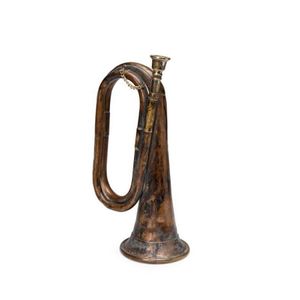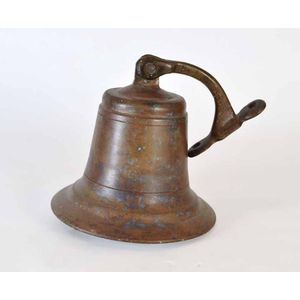Chinese Bronze Trumpet Water Dropper
You must be a subscriber, and be logged in to view price and dealer details.
Subscribe Now to view actual auction price for this item
When you subscribe, you have the option of setting the currency in which to display prices to $Au, $US, $NZ or Stg.
- Foo Dogs - Foo Dogs, also known as "Fo Dogs", "Fu Dogs", and " Buddhist lions" are the Chinese guardian lions that have traditionally stood in front of Chinese Imperial palaces and tombs, government offices, and the homes of the influential are believed to have powerful mythic protective benefits.
They are a popular motif in decorative arts, especially ceramics and garden statuary, where they are depicted in pairs, comprising of a male resting his paw upon an embroidered ball, representing supremacy over the world, and a female restraining a playful cub, representing the nurturing properties of the female. - Finial - An architectural decoration, found on the upper parts of of an object. On furniture they are usually found on pediments, canopies and shelf supports. On smaller ceramic or silver items, such as spoons, they may decorate the top of the item itself, or the lid or cover where they provide a useful handle for removal.
Finials have a variety of shapes and forms. They may be urn-shaped, baluster shaped round or spiral, but usually taper into an upper point. Many real life shapes may also be used as finials, such as pineapples, berries, pinecones, buds, lotus and acorns. Sometimes animals such as a lion are depicted, or fish and dolphins. - Bronze - An alloy of copper and tin, traditionally in the proportions of about 9 parts of copper to 1 part of tin.
The discovery of bronze in Western Asia in the 4th century enabled people to create metal objects which were superior to those previoulsy possible because of its strength and hardness, and it has been used throughout the world for weapons, coins, tools, statuary and other decorative items.
It is very fluid in a molten state, and its hardness, strength when set, and non-corrosive properties makes it most suitable for casting sculpture.
This item has been included into following indexes:
Visually similar items

Chinese bronze water Dropper, of bell form with dragon handle and lion finial with darkened, worn patina

Australian World War I period bugle stamped 'Gallipoli Landing Dardanelles April 25th 1915'. 29 cm

An Edwardian sterling silver coffee pot, 1911 London, with maker and retailer's marks for Hardy Bros, a plain pear shaped pot with a domed lid with knop, having an elegant long tapering square section spout and an ebony handle; hallmarked to upper body and

An early brass ships bell a quarter deck brass ships bell found on a shipwreck near Batam Singapore. Height 20 cm
